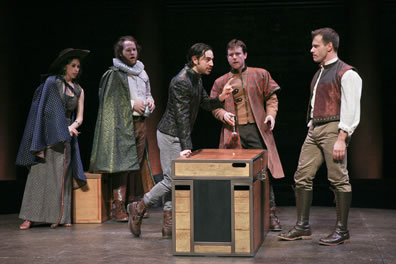A Conversation with the Founders of Fiasco Theater
[Return to Introduction]
First of all, I saw your Measure for Measure and loved it.
BEN: Thank you.
I've not seen your Cymbeline but I will be seeing it here at The Folger when you do it, as well as the Two Gents. In listing those three plays, I am always struck by the fact that you've done Cymbeline, Measure for Measure, and Two Gentlemen of Verona—extremely popular plays, those are, [Laughter] the ones that everybody does, the ones that everybody loves—
BEN: Right, right.
So how do you choose your plays? I know you did Twelfth Night some time ago, and you can give me the context for that one. How did you choose Cymbeline, Measure for Measure, Two Gentlemen of Verona? Where does that come from?
NOAH: We are all actors. We self-identify as actors first. We choose plays based upon a series of criteria. First of all, plays that have parts that we really want to play, with interesting subject matter, theme, and content. We look for plays that can function as ensemble pieces, either because they are by their nature, or because we craft them into ensemble plays through our understanding of them, the way we have a tendency to double and triple [thematically].
We haven't actually looked at each other and said, "Hey, let's find these problematic plays or plays that aren't so popular." They are actually the ones that made the most sense to us based upon the cast, the people that we have available, and the things we find interesting about those plays. But it is interesting that it has turned out that those plays are among the most problematic to successfully stage.
I'll leave it at that, if you guys want to jump in.
JESSIE: Yeah, that's what I would have said, too. Ben, do you have anything you want to add?
BEN: No, I think that's it. We pick plays that can be done as ensemble pieces and that have lots of good parts. That's the primary criteria.
[VIA EMAIL: Noah mentioned among the criteria for choosing the plays that, as actors, there are certain parts you guys want to play. What parts in particular did you three pursue from the outset in Cymbeline, Measure, and Two Gents? Does casting further evolve during the full-cast collaboration process?
JESSIE: I was dying to play Imogen in 2009; that was a major driving factor, I think. Yes, the casting conversation is evolving as the company evolves. Now that we have more than one show on the horizon we're trying to take into consideration what challenges each of us are looking for and to balance out the casting in relation to what parts people got to the play in the previous show.]
OK, so let's talk Cymbeline first, that's your first really, really big hit. There are so many parts in that, so many characters, and since I can't visualize it, how difficult was that to get down to just six people, especially that last scene?
JESSIE: It was our very first project, we were this tiny little company, the three of us got together and wanted to make a company, and we wanted to do Cymbeline because we were all excited by the text and the parts we wanted to play. We wanted to make it worth actors' while to come on board with us, so we wanted to double and triple as many parts as possible to make it a real ensemble show, so part of why we create tracks that double and triple characters is so that each actor gets a lot to work on, and nobody plays a spear carrier who waits off stage for two hours doing a crossword puzzle. We wanted it to be a real ensemble show where everybody was invested and had something to really challenge them as an actor.

Iachimo (Ben Stenfield, center) offers a wager to Posthumous (right) in Fiasco's Cymbeline. Looking on, from left, are Emily Young, Andy Grotelueschen, and Paul Coffey. At the center is another of the production's stars, the trunk designed by Jacques Roy. Photo by Ari Mintz, Fiasco Theater.
Part of it was math, figuring out how few people could we do it with so that we had something to chew on. From there, we looked at what made it interesting in terms of characters doubling, to see the same actor play two very different parts thematically. And it made sense for that show because one of the big thematic hooks for us is it's about the limits of belief and seeming. The roles lined up thematically because so much of the play's content is about thinking something is one thing because it seems that way on the outside but is actually something different on the inside. So, thematically we chose to have Imogen as the only actor who doesn't double. She's sort of at the center of the story, and she also dresses like a boy, so she inherently doubles in the play anyway. And then the other five actors all double or triple.
Which is similar to what you did in Measure for Measure with the Duke going into disguise.
JESSIE: Yep.
In Measure for Measure, one thing I noticed and actually put in my review was that the parts you played were almost opposites: Isabella was Mistress Overdone, that kind of thing. Was that intentional or was that just the way you divided out the script?
NOAH: That was absolutely intentional. We were sort of looking at Measure for Measure as a play in which characters inhabited three different spheres to more or less degrees: the head, the heart, and the guts or the groin. We were very interested in actors having tracks in which they would live in completely opposite worlds and how that would resonate with the audience. Since all these characters are having to inhabit one extreme or the other or to deal with the confluence and conflict of their separate worlds, that would have an interesting thematic resonance for us.
Is there something we can expect with that on Two Gentlemen of Verona as well?
BEN: Yeah. All the [doubling] choices we try to relate to what we think is going on in the play. So, the doubling that we're doing in Two Gentlemen of Verona has mostly to do with servants and masters, which is one of the big themes in the play. So, what we try to have is a situation where we have three actors who play Julia and Proteus and Valentine, and then three actors who play a servant to or master of, or rival of those characters. So, for example, the woman who plays Lucetta also plays Silvia, so she goes from being Julia's servant to being her superior in terms of status. Then we have the actor playing Speed, who serves Valentine, becomes Thurio, who is Valentine's rival for Sylvia. Does that make sense?
Yes, it does.
So the doubling is based on what we might call status, but primarily it's the idea of having servants and masters and how to reverse those polarities with the casting.
Is it six of you for Two Gents?
BEN: That's right.
[VIA EMAIL: Following on Fiasco's approach to thematic doubling, Shakespeare had a larger company than six and, by the time of Measure for Measure was writing for a specific troupe of actors, as he also probably did with Cymbeline. So, I don't expect that you are in any way following his approach to casting, but are you nevertheless gleaning what might be intentional character juxtapositions in his plays from the fact that you are doubling in such a way?
JESSIE: Yes, there are clearly plays with tracks where doubling seems apparent, or at least easy, so it's quite possible Shakespeare's company doubled those particular parts as well. Sylvia/Lucetta felt like a no-brainer in that regard for Two Gents. And I love productions of Lear that double Cordelia and the Fool, which seems likely to have been written to do so. Scholars know much more about this than I do though.]
You've brought up themes. In Measure for Measure, you had the six doors representing the city and the different doors in cities and what's inside and what's outside the doors, the access and nonaccess, what's behind closed doors but you can still get back there, and all that.
BEN: That's right
I was very much taken by—and Measure for Measure is one of my favorite plays—very much taken with how well you guys—and I'm no scholar by any means—but how well you guys really capture Shakespeare's thematic arc in that play, all the different allegories that he brings out. How studied are you in Shakespeare? Did you come into the play that way or did this come out of the rehearsal process?
BEN: I'll just jump in real quick on that. We've all studied Shakespeare academically in college, but the work that we do on the intellectual aspects in the play really comes through workshops and rehearsals and group discussions. We're trying to listen to the play as much as we can and tease out what we think is going on thematically. So, rather than kind of sitting around and talking about it, which we do a fair amount of, what we really try to do is receive what signals the play is sending us about what kind of initiatives and ideas are imbedded in it from the opening moments of the show all the way through the end, and once we've hooked into what the underlying vocabulary and architecture is, then we can talk about the handful of things that we think are really going on in the show and decide how to try to capitalize on that with the way we put it on stage.
Does it happen in part because you are a six-person repertory?
BEN: How do you mean?
As opposed to 12 actors suddenly showing up for a reading.
BEN: Oh, yes yes, a lot of it is definitely based on our long pair of relationships that we have with each other from grad school and our training together and the fact that we learned how to make theater together, so we've been having these conversations for a long, long time.
JESSIE: [There's a] quote that went something like, "There is no limit to what can be achieved when no one person gets the credit." We really work as an ensemble to try to tease out together what we think Shakespeare was after, which, for us, has proven much more fruitful and easier than any one person trying to have all the ideas alone, or even trying to decode what we think Shakespeare alone was after. But doing it together and hearing it aloud over and over has proven very useful for us.
[To continue the interview, click here] [For a PDF of this interview, click here]



 Find additional Shakespeareances
Find additional Shakespeareances